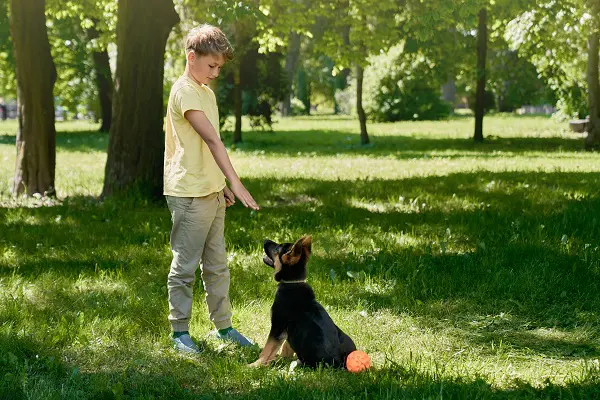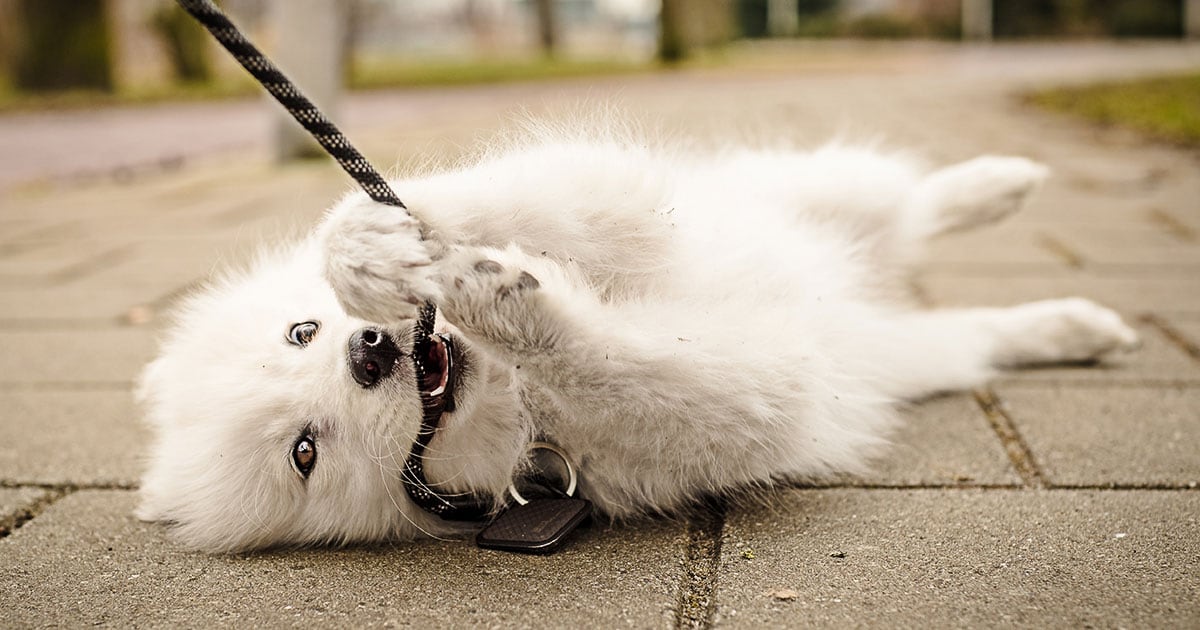
Last Updated on 2 years by Jenny Sovann
Want to know how to train a stubborn dog with ease? That feeling when you finally realize you are not in control, your dog is. It turns you into an expert negotiator to actually make your furry companion give in to your requests. Either way, if you love them too much to accept the chilling feeling, they will never obey you. After all, their loyalty and love know no bounds. They still make for great companions despite the daily drama you have to face. It’s comical if they finally find those lost socks, that they are guilty of losing in the first place. There are so many positive things to having a furry companion, but the only thing you want is to make him/her behave a little.
There are ways you can be creative to get your dog to be well-behaved. From a good workout to walks and finally some training. It is important that you finally become an expert in dog psychology and learn to anticipate and modify your dog’s behavior. You will appreciate the small victories when your dog finally learns you are the “Alpha ”. Training a stubborn dog should not be a challenge you dread, it should be more of a bonding experience for your dog. With that in mind, let’s delve into how to train a stubborn dog the easy way.
Understanding Your Dog
You have to decipher your canine companion’s code to effectively train them fully. Some dogs have a dominant personality, meaning they will always want to be controlled. These are descendants of wolves remember, if they have such a personality, establish yourself as the pack leader. Other times, your furry friend just lacks socialization. Most people get dogs as puppies, which are not exposed to enough people, animals, or experience. These dogs end up being stubborn or aggressive in turn. Your canine companion may also lack enough motivation to actually do the right thing you want them to.
Fear and anxiety are some of the disheartening reasons your dog could be going through. When you want them to do a task that is uncomfortable for them, they will just end up growling at you. Other times, your furry companion may be from a breed with high energy levels. If they don’t get enough exercise, all this energy will be translated into stubbornness. Unfortunately, health issues may also be a cause. Some dogs become stubborn if they experience pain or discomfort. It is important that you get your furry buddy checked up for health-related issues. It is important to uncover what is causing your canine companion to behave in this peculiar manner, to actually find a reliable solution.

Positive Reinforcement
As much as training stubborn dogs can be challenging, dogs are suckers for the good things in life. Using positive reinforcement will get even the most stubborn dog to behave. This is where you reward your canine companion for behaving in the way you want him to. Since we are dealing with a stubborn dog, you have to first find the right reward. Dogs respond differently to different rewards, so you should experiment with different types.
You have to first start with small steps. Set achievable goals for your particular stubborn dog. Some basic obedience commands like “come”, “stay” and “sit”, will give you a little control. Rewarding them for taking these steps with toys, treats or praise will get them aligned in no time. Remember that timing is crucial, you must reward your furry companion immediately after this desired behavior. This way, they will immediately associate the behavior with the command. Keep the training sessions short, this way the dog won’t be overwhelmed by the commands. You can gradually increase the level of complexity. This is a great opportunity for you and your dog to build trust and improve your overall relationship.
Manage Your Dogs Environment
Getting to train a stubborn dog is not easy especially if they keep getting distracted. It is important that you ensure you are in control of everything around your funny companion. For starters, you can set up a private area you are in control of, ensuring there are no destructions. This way, your stubborn boy will be engaged with you during the training sessions. You can then gradually introduce distractions in a controlled manner. This way, your canine companion will learn how to handle them past training.
Great, you can now adjust to the environment. Making it more challenging by moving to new environments if your furry companion can handle distractions. Using positive reinforcement throughout the process will increase your odds of success. You can also consider using items like a crate or baby gates to control your dog’s movement. It is important that none of the techniques you apply feel like a patient to your furry companion. Slowly, your stubborn dog will start giving you the respect you deserve.
Troubleshooting Challenges
It is important that you learn how to combat some of the problems that may arise during training. A stubborn dog is sure to give you double the trouble an ordinary dog will give you. If your furry companion seems unmotivated, the good old reward system will give him/her something to look forward to. They may also show short attention spans. If this is the case, use short but frequent training sessions to keep your dog engaged. Some dogs may ignore commands, so it is important to slowly and gradually increase the distance before introducing distractions.
The most dreaded trait in stubborn dogs is aggression. This is a reason some people will give up altogether on training their dogs. The occasional growling or snarling, barking or lunging, raised hackles, twitching, stiffening teeth, or even charging and attacking. Nobody has to explain how catastrophic this may result. In this case, you may have to take your time trying to condition your dog. These are dangerous signs if shown by a dog and seeking professional help should be your priority. With the right approach and technique, your stubborn dog will ultimately be successfully trained.
Patience And Persistence
Even training non-stubborn dogs usually takes time. With stubborn dogs, it can be a little bit more frustrating. It will take time to train your furry companion, so it is important to stay calm and keep being consistent. Sticking to a training routine will improve the overall progress of the training session. You have to remember that dogs are animals that thrive on repetition. You can break down training into small steps that you practice until your furry companion masters them all.
Using the ultimate technique, positive reinforcement, you will motivate your dog to display the desired behavior. Being consistent on the other hand ensures that your dog grasps your alien dialect. Do not use many commands at once or different commands to mean the same thing. This will confuse the dog and make the training sessions unproductive. Staying dedicated, patient, and persistent will waver your furry companion’s “Alpha” attitude, and finally, you will be the boss in the house.

Frequently Asked Questions
How do you discipline a dog that won’t listen?
If you are wondering how to train a stubborn dog then, you have to first know the underlying reason why your dog won’t listen. You can remove privileges or verbal corrections to discipline. Lack of training is a major reason why your dog probably won’t listen to you. With positive reinforcement, you can get your dog to show the desired behavior.
What causes a dog to be stubborn?
There are a number of factors that can cause a dog to be stubborn. Rear, anxiety, health, or lack of socialization are just some of the reasons why your dog may be stubborn. Some breeds are also known for their stubbornness like the Bull Terrier.
How do you train a stubborn dog?
With some patience and the use of positive reinforcement, you can get a stubborn dog to obey. Remember to teach your dog tailored to his specific needs, using rewards they like to encourage desired behavior.
Are some dogs untrainable?
Some dogs may be more challenging than others to train, but no dog is entirely unattainable. It will take the use of positive reinforcement and the right training techniques to manage this. It is important to be patient and consistent throughout the process.
At what age do dogs become disobedient?
Dogs can be disobedient at any age. Like most human beings though, disobedience in dogs can also develop during adolescence, which is usually between six months and two years of age. Dogs become challenging during this period.
What is the hardest dog to train?
This can vary depending on an individual dog’s personality, temperament, and breed characteristics. Breeds known for their independence or high energy are more likely to be more challenging such as Siberian Husky.
Conclusion
In conclusion, with a little technique, even the most stubborn dog will finally fall in line. You have to be patient, consistent, and understanding of your dog’s learning style and behavior. Using positive reinforcement will make your dog much more eager to obey you. It can be frustrating having a stubborn dog, but any dog lover loves their dog regardless. You don’t need a lot of experience to get your dog into obeying you. Remember to always consult professionals when signs of aggression seem uncontrollable. Overall, following the tips outlined in this guide will have your stubborn canine companion behaving in no time.



